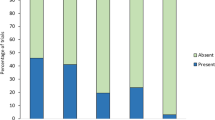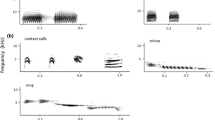Abstract
Field observations and model-presentation experiments have shown that yellow warblers (Dendroica petechia) produce “seet” calls preferentially in response to brood-parasitic brown-headed cowbirds (Molothrus ater). In this study, we investigated whether seet calls are functionally referential alarm calls denoting cowbirds by determining whether female warblers responded appropriately to seet calls in the absence of a cowbird, whether alarm calling by warblers varied with response urgency, and how warblers in a population allopatric with cowbirds responded to cowbird and avian predator models and seet playbacks. As a control, we presented “chip” calls, which are elicited by nest predators as well as by non-threatening intruders, but are not strongly associated with cowbirds. Yellow warblers responded differently to playbacks of seet than chip calls. To seet playbacks, almost 60% of females gave seet calls and rushed to sit in their nests, responses typically elicited by cowbirds, whereas these responses were given infrequently in response to chip calls. Yellow warblers seet called equally in situations that simulated low, medium and high risk of parasitism, which suggests that these calls did not vary with response urgency. In a population allopatric with cowbirds, seet calls were rarely produced in response to cowbird or avian nest predator models and never to seet playbacks. These results suggest that seet calls are functionally referential signals denoting cowbirds and that cowbird parasitism was a strong selective pressure in the evolution of functional referentiality in the seet call of yellow warblers.






Similar content being viewed by others
References
Berger J, Monfort SL, Roffe T, Stacey PB, Testa JW (2003) Through the eyes of prey: how the extinction and conservation of North America’s large carnivores alter prey systems and biodiversity. In: Festa-Bianchet M, Apollonio M (eds) Animal behavior and wildlife conservation. Island Press, Washington, DC, pp 133–155
Blumstein DT (1995) Golden-marmot alarm calls: I. the production of situationally specific vocalizations. Ethology 100:113–125
Blumstein DT, Armitage KB (1997) Alarm calling in yellow-bellied marmots: I. The meaning of situationally variable alarm calls. Anim Behav 53:143-171
Briskie JV, Sealy SG, Hobson KA (1992) Behavioral defenses against avian brood parasitism in sympatric and allopatric host populations. Evolution 46:334–340
Byers JA (1998) American pronghorns: social adaptations and the ghosts of predators past. University of Chicago Press, Chicago
Coss RG (1993) Evolutionary persistence of ground squirrel antisnake behavior: reflections on Burton’s commentary. Ecol Psychol 5:171–194
Duckworth JW (1991) Responses of breeding reed warblers Acrocephalus scirpaceus to mounts of sparrowhawk Accipter nisus, cuckoo Cuculus canorus and jay Garrulus glandarius. Ibis 133:68–74
Evans CS (1997) Referential signals. In: Owings DH, Beecher MD, Thompson NS (eds) Perspectives in ethology. Plenum, New York, pp 99–143
Evans CS, Evans L, Marler P (1993) On the meaning of alarm calls: functional reference in an avian vocal system. Anim Behav 46:23–38
Falls JB (1982) Individual recognition by sounds in birds. In: Kroodsma DE, Miller EH (eds) Acoustic communication in birds. Vol. 2 Academic Press, New York, pp 237–278
Fichtel C, Kappeler PM (2002) Anti-predator behavior of group-living Malagasy primates: mixed evidence for a referential alarm call system. Behav Ecol Sociobiol 51:262–275
Ficken MS (1990) Acoustic characteristics of alarm calls associated with predation risk in chickadees. Anim Behav 39:400–401
Ficken MS, Ficken RW (1965) Comparative ethology of the chestnut-sided warbler, yellow warbler, and American redstart. Wilson Bull 77:363–375
Ficken MS, Witkin SR (1977) Responses of black-capped chickadee flocks to predators. Auk 94:156–157
Foster SA (1994) Inference of evolutionary pattern: diversionary displays of three-spined sticklebacks. Behav Ecol 5:114–121
Gill SA (1995) Information transfer, function, and evolution of yellow warbler alarm calls. MSc thesis, University of Manitoba, Canada
Gill SA, Sealy SG (1996) Nest defence by yellow warblers: recognition of a brood parasite and an avian nest predator. Behaviour 133:263–282
Gill SA, Sealy SG (2003) Tests of two functions of alarm calls given by yellow warblers during nest defence. Can J Zool 81:1685–1690
Gill SA, Neudorf DL, Sealy SG (1997) Host responses to cowbirds near the nest: cues for recognition. Anim Behav 53:1287–1293
Godfrey WE (1986) The birds of Canada. National Museum of Natural Sciences, Ottawa
Goossen JP, Sealy SG (1982) Production of young in a dense nesting population of yellow warblers, Dendroica petechia, in Manitoba. Can Field-Nat 96:189–199
Gyger M, Marler P, Pickert R (1987) Semantics of an avian alarm call system: the male domestic fowl, Gallus domesticus. Behaviour 102:15–40
Hobson KA, Sealy SG (1989a) Responses of yellow warblers to the threat of cowbird parasitism. Anim Behav 38:510–519
Hobson KA, Sealy SG (1989b) Mate guarding in the yellow warbler Dendroica petechia. Ornis Scand 20:241–249
Hobson KA, Villard M-A (1998) Forest fragmentation affects the behavioral response of American redstarts to the threat of cowbird parasitism. Condor 100:389–394
Hobson KA, Bouchart ML, Sealy SG (1988) Responses of naive yellow warblers to a novel nest predator. Anim Behav 36:1823–1830
Le Roux A, Jackson TP, Cherry MI (2001) Does Brants’ whistling rat (Parotomys brantsii) use an urgency-based alarm call system in reaction to aerial and terrestrial predators? Behaviour 138:757–773
Leger DW, Owings DH, Boal LM (1979) Contextual information and differenitial responses to alarm whistles in California ground squirrels. Z Tierpsychol 49:142–155
Lindholm AK, Thomas RJ (2000) Differences between populations of reed warblers in defences against brood parasitism. Behaviour 137:25–42
Lorenzana JC, Sealy SG (1999) A meta-analysis of the impact of parasitism by the brown-headed cowbird on its hosts. Stud Avian Biol 18:241–253
McLaren CM, Sealy SG (2000) Are nest predation and brood parasitism correlated in yellow warblers? A test of the cowbird predation hypothesis. Auk 117:1056–1060
Macedonia JM (1990) What is communicated in the antipredator calls of lemurs: evidence from playback experiments with ringtailed and ruffed lemurs. Ethology 86:177–190
Macedonia JM, Evans CS (1993) Variation among mammalian alarm call systems and the problem of meaning in animal signals. Ethology 93:177–197
Manser MB (2001) The acoustic structure of suricates’ alarm calls varies with predator type and the level of response urgency. Proc R Soc Lond B 268:2315–2321
Manser MB, Bell MB, Fletcher LB (2001) The information that receivers extract from alarm calls in suricates. Proc R Soc Lond B 268:2185–2491
Marler P, Evans CS, Hauser MD (1992) Animals signals: motivational, referential, or both? In: Papousek H, Jürgens U, Papousek M (eds) Nonverbal vocal communication: comparative and developmental approaches. Cambridge University Press, Cambridge, pp 66–86
Naguib M, Mundry R, Ostreiher R, Hultsch H, Schrader L, Todt D (1999) Cooperatively breeding Arabian babblers call differently when mobbing in different predator-induced situations. Behav Ecol 10:636–640
Neudorf DL, Sealy SG (1992) Reactions of four passerine species to threats of predation and cowbird parasitism: enemy recognition or generalized responses? Behaviour 123:84–105
Neudorf DL, Sealy SG (1994) Sunrise nest attentiveness in cowbird hosts. Condor 96:162–169
Ortega CP (1998) Cowbirds and other brood parasites. University of Arizona Press, Tucson
Owings DH, Morton ES (1998) Animal vocal communication: a new approach. Cambridge University Press, Cambridge
Pereira ME, Macedonia JM (1991) Ringtailed lemur anti-predator calls denote predator class, not response urgency. Anim Behav 41:543–544
Post W, Nakamura TK, Wiley JW (1990) Patterns of shiny cowbird parasitism in St. Lucia and southwestern Puerto Rico. Condor 92:461–469
Prather JW, Ortega CP, Cruz A (1999) Aggressive responses of red-winged blackbirds (Agelaius phoeniceus) toward brown-headed cowbirds (Molothrus ater) in areas of recent and long-term sympatry. Bird Behav 13:1–7
Regosin, JV (2002) Alarm calling and predator discrimination in the Arabian babbler (Turdoides squamiceps) Bird Behav 15:11–19
Reid ML, Sealy SG (1986) Behavior of a polygynous yearling yellow warbler. Wilson Bull 98:315–317
Røskaft E, Moksnes A, Stokke BG, Bicík V, Moskát C (2002) Aggression to dummy cuckoos by potential European cuckoo hosts. Behaviour 139:613–628
Rothstein SI (2001) Relic behaviours, coevolution and the retention versus loss of host defences after episodes of avian brood parasitism. Anim Behav 61:95–107
Sealy SG (1994) Observed acts of egg destruction, egg removal, and predation on nests of passerine birds at Delta Marsh, Manitoba. Can Field Nat 108:41–51
Sealy SG (1995) Burial of cowbird eggs by parasitized yellow warblers: an empirical and experimental study. Anim Behav 49:877–889
Sealy SG, Neudorf DL, Hill DP (1995) Rapid laying by brown-headed cowbirds Molothrus ater and other parasitic birds. Ibis 137:76–84
Sealy SG, Neudorf DL, Hobson KA, Gill SA (1998) Nest defence by potential hosts of the brown-headed cowbird : methodological approaches, benefits of defence, and coevolution. In: Rothstein SI, Robinson SK (eds) Parasitic birds and their hosts. Oxford University Press, New York, pp 194–211
Sealy SG, McMaster DG, Gill SA, Neudorf DL (2000) Yellow warbler nest attentiveness before sunrise: antiparasite strategy or onset of incubation? In: Smith JNM, Cook TL, Rothstein SI, Robinson, SK, Sealy SG (eds) Ecology and management of cowbirds and their hosts. University of Texas Press, Austin, pp 169–177
Seddon N, Tobias JA, Alvarez A (2002) Vocal communication in the pale-winged trumpeter (Psophia leucoptera): repertoire, context and functional reference. Behaviour 139:1331–1359
Seyfarth R, Cheney D (1990) The assessment by vervet monkeys of their own and another species’ alarm calls. Anim Behav 40:754–764
Seyfarth RM, Cheney DL, Marler P (1980) Vervet monkey alarm calls: semantic communication in a free-ranging primate. Anim Behav 28:1070–1094
Studd, M, Robertson RJ (1985) Sexual selection and variation in reproductive strategy in male yellow warblers (Dendroica petechia). Behav Ecol Sociobiol 17:101–109
Tewksbury JJ, Martin TE, Hejl SJ, Kuehn MJ, Jenkins JW (2002) Parental care of a cowbird host: caught between the costs of egg-removal and nest predation. Proc R Soc Lond B 269:423–429
Warkentin KJ, Keeley ATH, Hare JF (2001) Repetitive calls of juvenile Richardson’s ground squirrels (Spermophilus richardsonii) communicate response urgency. Can J Zool 79:569–573
Wiley JW (1985) Shiny cowbird parasitism in two avian communities in Puerto Rico. Condor 87:165–176
Yezerinac SM, Weatherhead PJ (1997) Extra-pair mating, male plumage coloration and sexual selection in yellow warblers (Dendroica petechia). Proc R Soc Lond B 264:527–532
Zuberbühler K (2000) Referential labelling in Diana monkeys. Anim Behav 59:917–927
Zuberbühler K, Noë R, Seyfarth RM (1997) Diana monkey long-distance calls: messages for conspecifics and predators. Anim Behav 53:589–604
Acknowledgements
We thank the Portage Country Club for permission to work on their property, and the staff of the Delta Marsh Field Station (University of Manitoba) and Churchill Northern Studies Centre for logistical support during the fieldwork. K. Caldwell and D.G. McMaster were instrumental in the field. Constructive comments were made by J.F. Hare, W.A. Searcy, M.J. Vonhof and two anonymous reviewers. This study was supported by scholarships and grants from NSERC, Faculty of Science (University of Manitoba), Frank M. Chapman Memorial Fund (American Museum of Natural History), and Northern Studies Training Program to S.A.G., and by a NSERC grant (A9556) to S.G.S.. Our research was conducted with the approval of the Canadian Council on Animal Care.
Author information
Authors and Affiliations
Corresponding author
Additional information
Communicated by W.A. Searcy
Rights and permissions
About this article
Cite this article
Gill, S.A., Sealy, S.G. Functional reference in an alarm signal given during nest defence: seet calls of yellow warblers denote brood-parasitic brown-headed cowbirds. Behav Ecol Sociobiol 56, 71–80 (2004). https://doi.org/10.1007/s00265-003-0736-7
Received:
Revised:
Accepted:
Published:
Issue Date:
DOI: https://doi.org/10.1007/s00265-003-0736-7




